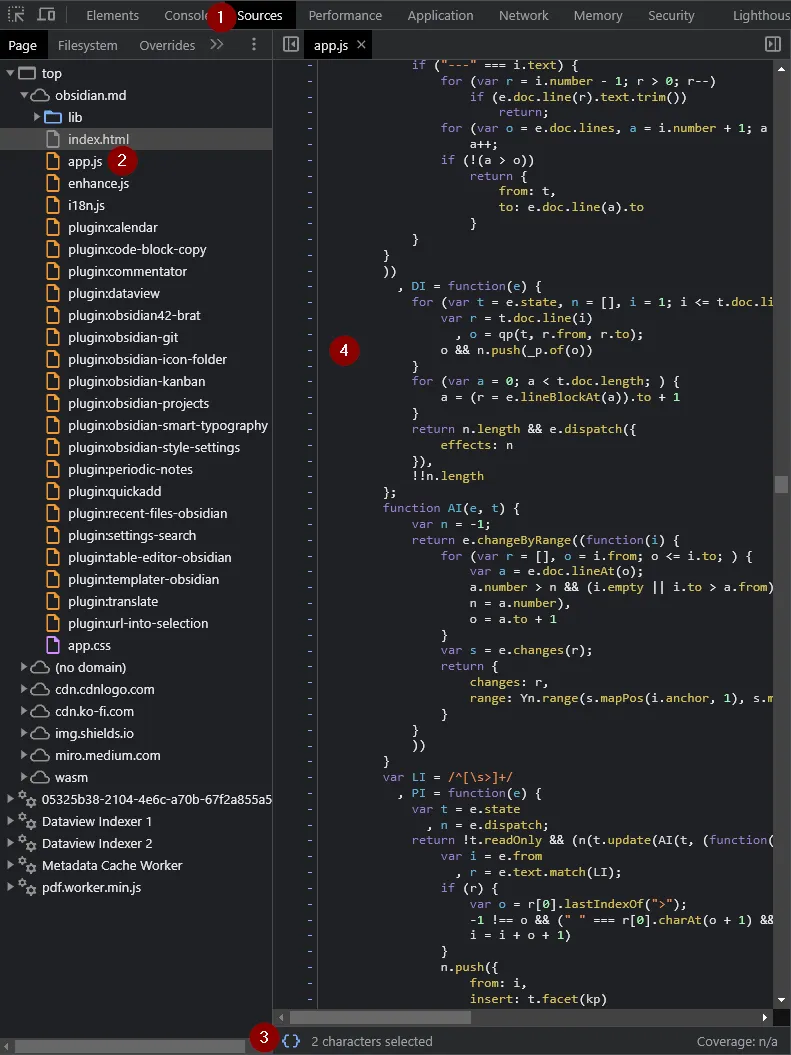Analyzing minified source code
Traversing and analyzing the source code
Section titled “Traversing and analyzing the source code”Sometimes just looking at the function name is not enough to understand what it does, that’s why it can be helpful to look at the actual definition of the function in the minified source code.
Start off by going to the console, and then to the Sources tab.
Here you will find the app.js file where all the internal methods are defined.
- Go to the
Sourcestab - Select the
app.jsfile Pretty formatthe code (optional)- Copy the code to your IDE of choice (optional, but recommended)

With access to the minified code, you can now start searching through it and find the definition of the method you are trying to type.
For any method “XYZ”, start by just searching for “XYZ”. Generally, the method is defined as either:
t.XYZ = ...(for static methods)t.prototype.XYZ = ...(for prototype methods)function XYZ((for internal/minified methods)
At this stage, you might get lucky and get a single definition, or you may get multiple definitions of the method. In the latter case, you will need try to look at the context of the code to determine which interface/class the method belongs to. The main tip for finding the correct definition, is to look at the other methods being defined on the prototype, and check if these match with the other methods of your object.
With the correct line found for the definition, you can now start analyzing the code to determine the input/output types and its behavior.
For example, the requestSaveConfig method (seen earlier) is defined as follows:
n.requestSaveConfig = at(n.saveConfig.bind(n), 1e3, !0),Here, we find the following three things:
atis a minified function that takes three arguments, and its return value is the return value of the method1e3is shorthand notation for1000!0is shorthand notation fortrue
(There are many shorthands and structural changes that you will need to get used to in the minified code)
Since we don’t know what at does, we need to start searching through the code again. Make sure to enable caps + whole word search, as at is a very common word.
Start by searching for function at, or .prototype.at. With any luck, this will lead you to the following definition:
function at(e, t, n) { void 0 === t && (t = 0), void 0 === n && (n = !1); var i, r = null, o = null, a = null, s = 0, l = function () { var t = o, n = a; /* ... */ };}You may want to pass the code through your favorite flavour of LLM or de-minifier to make the code at least somewhat understandable. Depending on whether you manage to decipher the code, you can now explicitly define the behavior and/or types of the method.
Async functions
Section titled “Async functions”Reverse engineering the async functions is more challenging.
In the app.js, you won’t see many async functions. Most of them are converted to the equivalent state machine code.
- If your function has
v(this, void 0,, it’s an async function. - If your function has
return [2], your function doesn’t return anything and the return type of your function will bePromise<void>. - If your function has
return [2, someValue], your function returnssomeValueand the return type of your function will bePromise<TypeOfSomeValue>. - If your function has
return [4, someValue], it corresponds toawait someValueand the awaited value is later retrieved asn.sent().
For more details how exactly it works, see The __generator helper documentation.